Title : How common is the uncommon vascular trauma amidst access gaps and trauma care disparities in global surgery
Abstract:
Introduction: Extremity vascular injuries are best addressed timely and are associated with a high morbidity and mortality.
This is a retrospective study from a developing world's level 1 public trauma center and vascular surgery referral centre which caters to a multi provincial population scattered over more than 100,000 square miles.
We frequently encounter delays in presentation owing to poor referral services and prolonged travel times between the hospital and place of injury. All these incidents contribute to a higher rate of limb loss and mortality, especially in the young population who are the most frequent victims of such injuries.
We aim to quantify the magnitude of extremity vascular trauma and report its demography alongside our center’s post intervention outcomes and limb salvage rates. This is a call for strengthened trauma systems and improving country-wide access to vascular surgery services.
Methodology: We conducted a retrospective review of all patients admitted with a vascular injury of the upper or lower extremity to our department from January to December 2023. Eligible participants were included from our online database and the details of their demography, time since presentation, operative findings and outcomes of limb salvageability and mortality were recorded. Data was entered and analyzed via SPSS v.23 and a p value of < 0.05 was considered significant.
Results: We included 254 cases of extremity vascular trauma. The mean age was 29.46 (13.03) years and 94% were males. 45% of patients presented from outside the city and the median time elapsed since injury was 12.5 (133) hours. The most common mechanisms of injury were firearms (49.6%) followed by road traffic accidents (17.7%) and glass cut injuries (7.5%). The lower limb was involved more frequently (67.7%) than the upper limb (32.3%). Concomitant bony and venous injuries were encountered in 35.4% and 30.7% cases respectively.
Arterial repair via native venous graft was undertaken in 51.6% cases, with ligation being performed in 25.6% and a primary amputation done in 12.6% of the patients. Additionally, 6.7% of patients required a secondary amputation.
Limb salvage rate was 80.3% overall, 92% for the upper and 66% for lower extremities. The highest rate of limb loss was associated with injury to the popliteal artery (up to 50%). Age, gender, mechanism of injury, and coexisting orthopedic or venous injuries had no statistically significant impact on limb salvage. However, a lower arrival hemoglobin was significantly associated with limb loss. (p=0.028)
Discussion: Extremity vascular trauma presents a significant healthcare concern with a high morbidity in young people. This needs to be addressed at multiple levels amid policy makers and government institutes, and prehospital trauma care and vascular surgery services should be expanded throughout the province. This will enable us to timely salvage limbs and also share the net burden of trauma on a single center.
In many cases, the critical salvage window even before reaching a vascular service.An important point to highlight here is that the provided data is an under-representation of the amputation rates as many non salvageable limbs are amputated at local levels without making it to our vascular service. Strengthening regional trauma networks and investing in training, pre hospital care, and transport is,therefore, a public health imperative.



